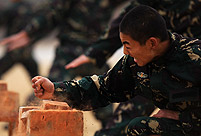CHENGDU, November 11 (ChinaMil) -- The China-India joint anti-terrorism military training code-named "Hand-in-Hand 2013" entered into the phase of mixed-force simultaneous training on November 6, 2013.
The officers and men of both sides participating in the training were divided into two companies, the "Company A" is composed of two platoons of the Chinese side and one platoon of the Indian side, a Chinese officer serves as the company commander; The "Company B" is composed of two platoons of the Indian side and one platoon of the Chinese side, an Indian officer serves as the company commander.
Scene 1: Li Xiang, squad leader under the "Company A", ever participated in the peacekeeping mission in Lebanon. He served as the instructor to explain to both the Chinese and Indian officers and men the search and elimination of those common improvised explosive devices (IED), such as parcel bombs, envelope bombs, water bottle bombs and so on.
Lt. Manide from the Indian side successively assembled and disarmed 8 IEDs under Li Xiang's guidance. He felt that the Chinese serviceman's explanation was very detailed.
Scene 2: "No! No!" Chinese soldiers were stopped by Indian soldiers during checking the "terrorists" killed in the "breaking in room and attacking" training.
According to the Indian officer, it is easy to be attacked by explosive devices such as hand grenades if you try to identify the body by directly turning it over. You should tie a rope onto the foot of the dead body and pull it from a distance in order to make sure there is no danger before you approach to the body for identification.
Hu Tianjiao, Chinese platoon leader of the mixed "Company B", commented that: "This is experience from actual battles. It is worth our learning."
Scene 3: During the training of rope-dropping from helicopters, the Chinese side used a nylon rappel rope of 3 cm in diameter, while the Indian soldiers used a rappel rope made up of three intertwined soft ropes of 12 mm in diameter.
After a round of personal experience, the Chinese soldiers got control of the training skills.
According to Li Chunlin, who has joined the army for 10 years: "The rappel rope of the Chinese side has better stability and better resistance against wind blowing, but it is heavier. The Indian side's rope is easy to carry and can be used for multiple purposes. Both sides have their own advantages and disadvantages."
Although the command department assigned interpreters to each mixed company, the officers on both sides exchanged mostly in English directly, and it enabled them to realize the key points of training in the maximum way.
Jin Weiqiang, platoon leader of the mixed "Company A", said that: "We can feel it through our conversation that those Indian officers participating in the joint training have abundant rich experience in actual combats".
According to Cao Xianfeng, commander of the Chinese side in the joint command department, the Chinese military and the Indian military have their respective strong points in the field of anti-terrorism. In the following days, both sides will enjoy deeper cooperation and understanding and further their learning and references from each other.
 Luxury-cars parade held in Dubai
Luxury-cars parade held in Dubai Special forces take tough training sessions
Special forces take tough training sessions Fire guts 22-storey Nigeria commercial building in Lagos
Fire guts 22-storey Nigeria commercial building in Lagos A girl takes care of paralyzed father for 10 years
A girl takes care of paralyzed father for 10 years A record of Beijing air quality change
A record of Beijing air quality change In pictures: explosions occur in Taiyuan
In pictures: explosions occur in Taiyuan Live a harmonious life in Pu'er, SW China
Live a harmonious life in Pu'er, SW China Weekly Sports Photos
Weekly Sports Photos Gingko leaves turn brilliant golden yellow in Beijing
Gingko leaves turn brilliant golden yellow in Beijing Maritime counter-terrorism drill
Maritime counter-terrorism drill Loyal dog waits for master for six months
Loyal dog waits for master for six months Oriental education or western education?
Oriental education or western education? China in autumn: Kingdom of red and golden
China in autumn: Kingdom of red and golden National Geographic Traveler Photo Contest
National Geographic Traveler Photo Contest Chinese screen goddesses from Beijing Film Academy
Chinese screen goddesses from Beijing Film Academy Day|Week|Month